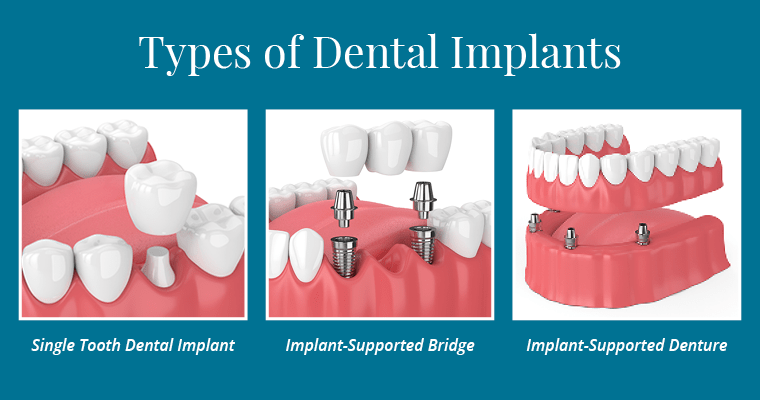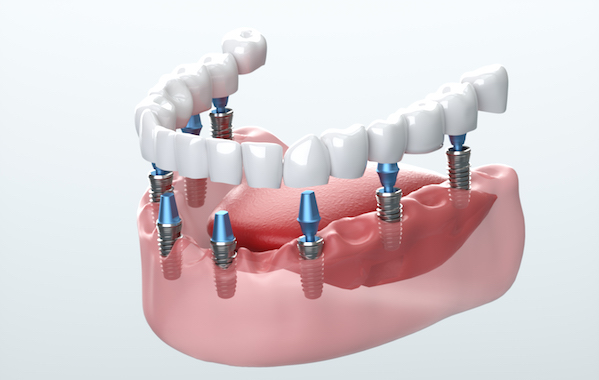The Only Guide to Dental Implants
Table of ContentsThe Buzz on Dental ImplantsSome Known Incorrect Statements About Dental Implants Little Known Facts About Dental Implants.Not known Facts About Dental Implants
are medical gadgets surgically implanted right into the jaw to recover a person's capability to eat or their look. They supply assistance for synthetic (phony) teeth, such as crowns, bridges, or dentures. When a tooth is lost due to injury or illness, an individual can experience problems such as quick bone loss, defective speech, or changes to chewing patterns that result in pain.
Structure of The Oral Implant System selecting dental implants, talk to your dental supplier concerning the possible advantages and dangers, and whether you are a candidate for the treatment. Things to think about: Your total health and wellness is an important consider establishing whether you are an excellent candidate for oral implants, the length of time it will require to recover, and for how long the implant may remain in place.
Cigarette smoking may impact the healing process and lower the lasting success of the implant. The recovery process for the dental implant body may take numerous months or longer, throughout which time you generally have a temporary abutment instead of the tooth. the oral implant procedure: Thoroughly follow the oral health instructions provided to you by your oral supplier.
Top Guidelines Of Dental Implants
Implant failing can lead to the requirement for another surgical procedure to take care of or replace the dental implant system. Restores the capacity to eat Restores aesthetic appearance Helps maintain the jawbone from shrinking as a result of bone loss Protects the health of the surrounding bone and gums Aids maintain surrounding (nearby) teeth steady Boosts quality of life Damages to bordering natural teeth throughout implant positioning Injury to the surrounding tissues throughout surgery, such as sinus opening Injury throughout surgical treatment (as an example, crack of surrounding jawbone) Poor feature, such as feeling like the teeth do not bite with each other generally A sensation that the tooth is loosened or turning in area arising from a joint screw loosening up Implant body failing (looseness of the dental implant body) due to systemic infection, which may be most likely in individuals with unrestrained diabetes mellitus as a result of local infection in bone and periodontals supporting the implant body because of delayed healing, which might be a lot more likely in clients who smoke Difficulty cleaning the gums around the implant, resulting in bad dental health Unattended gum condition Post-surgical feeling numb as a result of nerve this article impingement or damages Always notify healthcare companies and imaging service technicians that you have oral implants prior to any type of magnetic resonance imaging (MRI) or x-ray procedures.
FDA is not familiar with any type of damaging events reported for MRI or x-ray treatments with oral implants. Dental implants systems are generally made of materials that follow global agreement standards of the International Organization for Standardization (ISO) or ASTM International. These standards have information of what makes a risk-free material.
Other materials such as gold alloys, cobalt-based alloys, titanium alloys, or ceramic products are sometimes used. The safety and security profiles of these materials are widely known. Oral dental implant systems are assessed according to worldwide agreement standards. Biocompatibility screening, to reveal that physical contact with the gadget does not create issues like irritation or allergy, is component of the evaluation that assists ensure the products in the dental implant system are secure and do not create adverse effects when dental implanted in individuals.

The Single Strategy To Use For Dental Implants
Some individuals are not eligible for dental implant surgery. It is for dental doctors to operate on individuals with: severe illnessuncontrollable metabolic diseasebone or soft tissue disease or infectionIf these Website issues are settled, an individual can have the surgery. Dental Implants. In, dental cosmetic surgeons abstain from running on individuals with: If people with any of the above undergo dental implant surgical treatment, there is a greater risk of the implant stopping working
Some people have a jawbone irregularity that avoids adequate bone for an implant from developing. In such situations, a specialist may need to carry out a ridge modification. This entails raising the gum tissue to expose the area of deformed bone. The cosmetic surgeon will then make use of a bone or bone substitute to repair and accumulate the area.
Oral dental implant surgical treatment is a tailored process. Provide you time to heal. Connect the check out here post and final crown, bridge or denture.
Next off, your cosmetic surgeon will thoroughly position the dental implant right into your jaw. Your specialist will certainly reposition your gums and close the cut with stitches (Dental Implants). If your dental implant is near the front of your mouth, your dental expert will certainly make a short-term tooth for you to use till you heal. That means, you will not have a gap in your smile while you recover.
The Best Strategy To Use For Dental Implants
Throughout the recovery phase, your jawbone needs to fuse to the dental implant. This process can take anywhere from three to 9 months.
As soon as your implant heals, your dental expert can connect the joint (little connector blog post) and your last reconstruction (crown, bridge or denture). This generally takes regarding one hour to complete and might call for a 2nd small surgical procedure. You shouldn't feel any pain throughout your oral implant treatment since your company will certainly use drug to numb your gums.